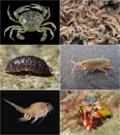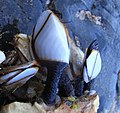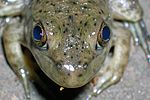Look up Nauplius or nauplius in Wiktionary, the free dictionary. Nauplius, Nauplia or Nauplios /ˈnɔːpliəs/, may refer to: Nauplius (mythology), in Greek...
854 bytes (123 words) - 23:11, 22 June 2023
Crustacean larva (redirect from Nauplius (larva))
genus name Nauplius was published posthumously by Otto Friedrich Müller in 1785 for animals now known to be the larvae of copepods. The nauplius stage (plural:...
22 KB (2,506 words) - 01:26, 4 June 2024
Barnacle (section Nauplius larva)
distinct larval stages, the nauplius and the cyprid, before developing into a mature adult. A fertilised egg hatches into a nauplius: a one-eyed larva comprising...
49 KB (4,712 words) - 10:27, 9 August 2024
Facetotecta (redirect from Y-nauplius)
never been recognised, and the group is known only from its larvae, the "y-nauplius" and "y-cyprid" larvae. They are mostly found in the north Atlantic Ocean...
9 KB (831 words) - 13:00, 12 April 2024
Sea-Monkeys (section Biology)
they are exposed to water. Once the eggs are in water, they hatch into nauplius larvae, which eventually develop into adult Sea-Monkeys. The entire life...
10 KB (1,087 words) - 10:43, 5 July 2024
Nauplius is a peer-reviewed open access scientific journal in the field of carcinology (crustacean research). It is published by the Brazilian Crustacean...
2 KB (132 words) - 13:40, 28 December 2023
antennae in crustaceans. Many crustaceans have a mobile larval stage called a nauplius, which is characterized by its use of antennae for swimming. Barnacles...
20 KB (2,130 words) - 17:13, 1 June 2024
of biramous (two-parted) limbs, and by their larval forms, such as the nauplius stage of branchiopods and copepods. Most crustaceans are free-living aquatic...
57 KB (4,861 words) - 16:27, 20 July 2024
Austromegabalanus psittacus (section Biology)
incubated for about three or four weeks. They then hatch into free swimming nauplius larvae which form part of the plankton. These pass through six stages over...
9 KB (931 words) - 10:45, 28 October 2023
statocysts and sensory bristles. The naupliar eye is a characteristic of the nauplius larva and consists of four cup-shaped ocelli facing in different directions...
30 KB (2,961 words) - 11:57, 19 July 2024
Allopetrolisthes spinifrons (Crustacea: Decapoda: Porcellanidae)" (PDF). Nauplius. 18 (1): 95–102. Archived from the original (PDF) on 2012-04-25. Tsang...
20 KB (2,097 words) - 02:43, 10 August 2024
Sexual reproduction (category Developmental biology)
water-breathers with extendable jaws. Crustaceans commonly hatch as tiny nauplius larvae that have only three segments and pairs of appendages. Insect species...
39 KB (4,860 words) - 05:18, 2 August 2024
relationships between taxa. Müller demonstrated that crustaceans shared the Nauplius larva, identifying several parasitic species that had not been recognized...
57 KB (6,279 words) - 17:31, 21 May 2024
the study of crustaceans include: Crustaceana Journal of Crustacean Biology Nauplius Crustaceans portal Arthropods portal Entomology Publications in carcinology...
4 KB (330 words) - 15:14, 10 May 2024
respiratory system. A nauplius eye is completely absent. After mating, mystacocarids lay tiny eggs which hatch into a nauplius or metanauplius larva....
8 KB (740 words) - 16:53, 4 June 2024
about 110 species, all parasites of coelenterates and echinoderms. The nauplius larvae (sometimes absent) can be both lecithotrophic (non-feeding) and...
7 KB (571 words) - 19:21, 31 July 2024
dries up. Eggs hatch into nauplius larvae, which consist of a head with a small tail, but no thorax or true abdomen. The nauplius moults five or six times...
39 KB (4,284 words) - 13:02, 12 April 2024
(PDF). Nauplius. 13 (1): 57–63. Peter C Dworschak (2000). "Global diversity in the Thalassinidea (Decapoda)" (PDF). Journal of Crustacean Biology. 20 (5):...
4 KB (336 words) - 02:34, 7 May 2021
offspring also hatch directly into fully developed cyprids instead of nauplius larvae (except for a few species of kentrogonid rhizocephalans, which hatch...
17 KB (1,896 words) - 11:36, 16 July 2024
species to species. After krill hatch, they experience several larval stages—nauplius, pseudometanauplius, metanauplius, calyptopsis, and furcilia, each of which...
66 KB (6,431 words) - 20:32, 7 August 2024
hatch into a nauplius, the usual early larval stage of crustaceans. This nauplius I moults about 10 minutes after hatching to produce nauplius II, and 48 hours...
10 KB (1,035 words) - 15:20, 10 April 2023
Lepas anatifera (section Biology)
brooded inside the mantle for a week before emerging as free-swimming nauplius larvae. After further development, drifting as part of the plankton, these...
6 KB (618 words) - 10:19, 20 December 2023
Petromyzon elongates very considerably during metamorphosis. Crustaceans at the nauplius stage (first-stage larva) have a single eye atop the head. The eye has...
14 KB (1,589 words) - 06:35, 5 July 2024
Edwards) (Decapoda, Brachyura, Grapsidae) from the western Atlantic" (PDF). Nauplius. 9 (2): 111–121. Raymond B. Manning & Fenner A. Chace, Jr. (1990). "Decapod...
9 KB (855 words) - 19:06, 10 July 2024
infralittoralis and Cytherella sordida, have been found to both possess a nauplius eye too. A new method is in development called mutual ostracod temperature...
37 KB (3,940 words) - 13:26, 3 July 2024
Antarctic krill (section Biology)
depths around 2,000–3,000 metres (6,600–9,800 ft). The egg hatches as a nauplius larva; once this has moulted into a metanauplius, the young animal starts...
40 KB (4,472 words) - 18:11, 8 August 2024
Allopetrolisthes spinifrons (Crustacea: Decapoda: Porcellanidae)" (PDF). Nauplius. 18 (1): 95–102. Archived from the original (PDF) on 2012-04-25. Nelson...
5 KB (448 words) - 17:12, 31 January 2022
to protect both territory and young. Larva develop in three stages: The nauplius larvae, zoea, and post larval stages. More than 620 species are currently...
17 KB (1,821 words) - 08:57, 20 July 2024
Night shark (section Biology and ecology)
"Records of parasitic copepods of sharks from the southwestern Atlantic". Nauplius. 4: 179–180. Knoff, M.; S.C. de Sao Clemente; R.M. Pinto & D.C. Gomes (July...
22 KB (2,681 words) - 21:15, 1 July 2024
Once placed in briny (salt) water, the eggs hatch within a few hours. The nauplius larvae are less than 0.4 mm in length when they first hatch. Parthenogenesis...
29 KB (3,164 words) - 18:34, 30 July 2024





























